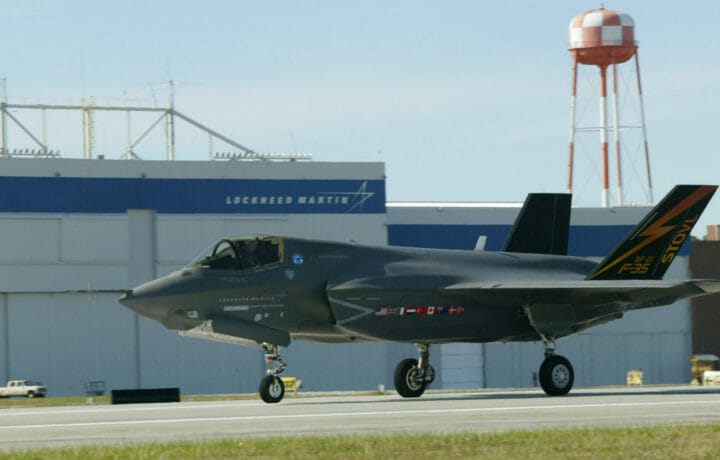Aerospace giant Lockheed Martin released its third-quarter financial results this week, reporting quarterly sales of $18.6 billion, an increase of more than $1.5 billion from the Q3 2024. Net earnings for the third quarter were $1.6 billion, approximately the same rate as last year.
The company continued to see strong demand for its fifth-generation F-35 Lightning II multirole fighter and was recently awarded multiple contracts.
The company also announced plans to carry out on-orbit demonstrations of its space-based, hit-to-kill interceptor by 2028. The missile platform is a key component of President Donald Trump’s Golden Dome for America program, which seeks to develop an air defense system that could protect the entire continental United States.
Lockheed Martin Touts a Strong Year
In the earnings call with investors, Lockheed Martin Chairman, President, and CEO Jim Taiclet remained bullish about the final quarter of 2025. He highlighted contract awards for the CH‑53K and PAC‑3 MSE programs, the largest ever for the aerospace firm’s rotary and mission systems and missiles and fire control businesses, respectively.
Taiclet added that Lockheed Martin finalized the contracts covering Lots 18 and 19 of the F‑35 early in the fourth quarter. To date, the company has delivered a record 143 F‑35 Lightning II jets during the third quarter.
Looking ahead, Taiclet said that the company has invested “aggressively in both new digital technologies and physical production capacity needed to meet the top defense priorities of the United States and its allies,” and it has included partnerships with a number of leading technology partners, large and small.
“Major national‑defense initiatives like the Golden Dome for America demand proven leadership in a wide range of skills, including integrated air and missile defense, space warfare, and highly secure command‑and‑control systems,” Taiclet explained. “Lockheed Martin is the capable leader and integrator across industry for these types of initiatives.”
Protection From the Heavens Above
The Golden Dome, which Trump first announced shortly after returning to the White House, could be one of the most extensive military programs undertaken by the United States, surpassing even the Manhattan Project of World War II. Military analysts have questioned whether it can be completed before Trump leaves office, with some arguing it could require decades and more than $1 trillion, given the scale of the project.
However, several major companies have lined up to be a part of it, including Lockheed Martin. It requires a rethinking of technology and platforms.
“On SBI [space-based interceptors], we are changing the way we allocate our independent R&D at this company,” said Taiclet on the earnings call. “We’ve been evolving towards this for the last five years, I think now we’re basically at the mountaintop here.
He further emphasized, “The previous way that the company tended to aggregate and fund IR&D [internal research and development] was, each of the business units would get sort of a slice of the pie, so to speak, and figure out what were the most important projects for their current or prospective pursuits.”
The Lockheed Martin CEO explained that the efforts are moving forward on SBI development, which has included building prototypes that are “full-up operational,” and “not things in labs, not stuff on test stands,” and instead are “things that will go into space, or in the air, or fly across a missile range. These are real devices that will work, and that can be produced at scale.”
The firm has also built a “prototyping environment” at its Center for Innovation facility in Virginia. Also known as “The Lighthouse,” the 50,000 square foot operations center provides both a physical and a virtual portal into the vast network of Lockheed Martin’s laboratories, research centers, and engineering facilities. The Lighthouse will support the collaborative development of Golden Dome’s command and control capability.
The Race to Space
Although the Golden Dome is based on Israel’s Iron Dome, which relies primarily on the ground-based Tamir interceptor missiles, the U.S. initiative will include the space-based interceptors.
China has also deployed its own missile defense system, which could leverage sensors in space, in the air, on the ocean, and on the ground. Moreover, China has continued to develop more advanced missiles, including those with hypersonic capabilities. That could add to the challenges in shooting them down. Moreover, Beijing has taken a lead on the development of anti-satellite weapons (ASAT), which could incapacitate or even destroy a satellite, impacting the capabilities of a defense network like Golden Dome.
Lockheed Martin’s SBIs don’t need to contend with a missile from an adversary like Russia or China at this point. Instead, the biggest threat could be from competition from Northrop Grumman, which has also been confirmed to be working on a similar SBI for the Golden Dome.
Other major aerospace and defense contractors expected to contribute to the missile defense system include Boeing, RTX, and SpaceX. Additional companies that could be involved are Anduril, Apex, L3Harris, Leonardo DRS, Parsons Corporation, and Palantir.
With potentially so many companies involved, the program could surpass the Manhattan Project in scale. However, going online by January 2029 seems increasingly unlikely, especially if the SBIs won’t be in orbit for testing until sometime in 2028.




